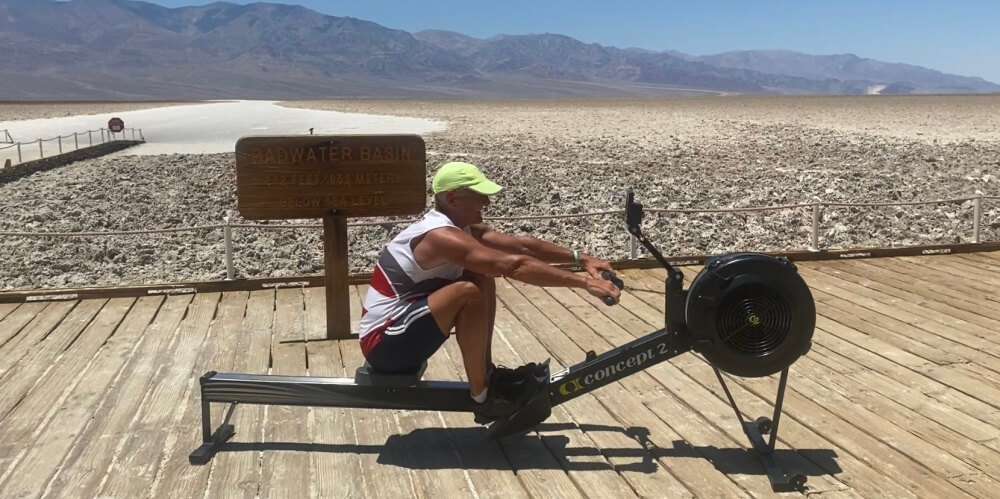Championship rower Dan Lynch is used to fighting against the current. Most people start the sport in their teens or twenties. Lynch dropped oars at 53 on a whim. Today, it isn’t a mere hobby. He’s now pursuing the longest-known streak of consecutive days on an indoor rowing machine. Not even mantle cell lymphoma, a rare form of non-Hodgkin lymphoma, will sink him.
In December 2017, Lynch read about a Canadian athlete who set a record by rowing for 1,048
straight days. He was inspired. At first, he thought he’d try to row every day for a month. He
kept it up. He enjoyed his local rowing community, the Litchfield Hills Rowing Club in
Connecticut, and its strong sense of camaraderie.
But 11 months later — on day 334 of his personal streak and in the prime of his life — cancer
struck. The diagnosis shocked him. He was active and fit. He loved cycling, running, and, of
course, rowing. Yes, he’d been a bit tired lately. And, yes, he’d lost weight. But surely it was due
to athletics, not cancer.
“I knew nothing at all about lymphoma. In fact, I truly did not even know that lymphoma was
cancer,” he says, laughing.
But that summer, he had noticed a peanut-sized lump in his groin. At first, he wrote it off as a
hernia.
“I thought, ‘Ugh. What an inconvenience for a rower,’” he remembers.
Cancer seemed impossible. After all, he’d rowed in the Head of the Charles Regatta two years running. In 2018, he was the Connecticut Indoor champion, winning 1,000- and 2,000-meter events for men in his weight and age group, and also made a strong showing at the World Rowing Indoor Championships, taking silver in the 500-meter and bronze in the 2,000-meter events. In August 2018, three months before his diagnosis, he set three American records in his weight and age category.
Just the same, Lynch offhandedly showed the lump to his primary care doctor during an annual
physical. Instead of brushing it off, the doctor recommended a same-day ultrasound — just as a
precaution, he said.
Things moved quickly after that. Lynch went to a hospital near his Connecticut home for an
excisional biopsy. Then a phone call changed his life.
“I remember standing at the kitchen counter one day, and they said the words ‘mantle cell
lymphoma.’ I was in shock,” he says.
Lynch was also disheartened by his initial oncology visits in Connecticut, where he felt pushed
into immediate chemotherapy. He also worried about his elderly parents, who had already lost
two children. What would they think if he, the healthy son, lost his hair or appeared frail? He
kept the diagnosis to himself, not even telling his two daughters.
“I called my sister, a long-time ovarian cancer survivor, and said, ‘I feel like I’m being forced into consenting to start chemo. I don’t even understand what’s the matter with me, and they’re telling me to start chemo within a period of days,’” he recalls.
Lynch was desperate for a second opinion. He called Dana-Farber and scheduled an
appointment with Caron Jacobson, MD, MMsc, an oncologist who specializes in lymphoma, for
the following week.
“And I just immediately loved everything about her. I loved her positivity, the way she
responded to me and answered my questions,” he says.

Mantle cell lymphoma
Mantle cell lymphoma is named for its origins in the mantle zone, a ring of cells within the
lymph nodes where B cells, a type of lymphocyte, grow and adopt specialized functions. It
comprises just six percent of non-Hodgkin lymphoma cases. And, while it can present aggressively, it can also follow a more slow-growing course in some cases. Due to the unusual nature of the disease, there isn’t a wide consensus on treatment. Lynch was reassured that Jacobson had treated it many times.
“She talked with a lot of specificity and a lot of confidence, which then gave me confidence that
I was sitting in the right chair,” he says.
He decided to receive treatment at Dana-Farber with two goals in mind: get healthy and keep
rowing.
Just as mantle cell isn’t a typical cancer, Lynch isn’t a typical cancer patient. He leveled with
Jacobson: He wanted to postpone chemo for as long as possible to spare his parents and to
keep rowing.
Jacobson sympathized. Traditionally, patients like Lynch receive six cycles of chemotherapy
followed by an autologous stem cell transplant and maintenance therapy with rituximab, a
monoclonal antibody. However, Jacobson understood how much rowing mattered to Lynch’s
mental health. Based on Lynch’s bloodwork and other metrics, she felt comfortable holding off
on aggressive chemo.
He saw Jacobson every three to six months to keep tabs on the lymphoma’s progression. And in
September 2019, he opted for radiation localized to his right groin. Meanwhile, he continued to
row at least 2,500 meters daily, more than the Olympic standard and the same minimum threshold as the Canadian record-holder, and used an indoor rower to keep up his streak. It was essential to his treatment.
“Rowing gave me that small element of control,” he says.

First cancer, then COVID
But control and cancer don’t always go together. In February 2020, the cancer spread to wrap
around his spinal column, pressing on a nerve and causing significant pain. Ultimately, he
needed chemotherapy. The world went into lockdown in March 2020, and Lynch began his
chemo regimen. He also broke the rowing record, clocking 1,086 days, bringing his rowing
machine to inpatient chemotherapy and blood transfusions, continuing to exercise despite strength-sapping anemia. He then began treatment with rituximab.
But in fall 2020, it was COVID — not cancer — that made him seriously ill with a prolonged case of
inflammatory pneumonia. The rowing streak ended when he arrived in a cardiac ICU and
needed pulmonary surgery. True to form, Lynch was more worried about his record than his
prognosis.
“The ironic aspect of this is, despite his lymphoma and aggressive lymphoma treatment, he
never missed a day of rowing until he came down with COVID,” Jacobson says. “But I think
because of who he is — because of his positive attitude and the outlets he’s found in terms of
focusing on physical health and fitness — he had a remarkable recovery.”
Returning to calm waters
COVID was a setback, but for now, the waters are calm again. He feels healthy, and he’s
working on a new streak (more than 547 days at last count, including a rowing trip in Death
Valley, California). He visits Dana-Farber every six months for bloodwork. He’s committed to
staying fit to fight his cancer should it recur. At 60, he’s aiming to compete in championships in the 60-69 age bracket — “while I’m still on the younger side,” he explains.
Both Lynch and Jacobson stress the importance of a candid doctor-patient relationship. Lynch
felt that he could be honest with Jacobson about his treatment priorities, and she listened.
“In cases where there’s more flexibility, I think it’s important to realize that nothing in medicine
is certain,” Jacobson says. “Sometimes we think there’s only one way in medicine and medicine
is absolute, but it’s absolutely full of gray areas.”
Just like those choppy seas.

So happy Mr. Lynch went to Dana Farber! I wish him a good recovery and keep rowing!🙏